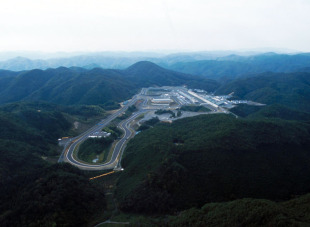
- Drivers:
- Jaime Alguersuari
- |
- Jim Clark
- |
- Denny Hulme
- |
- Alain Prost
- |
- Jody Scheckter
- |
- Michael Schumacher
- |
- Ayrton Senna
I happened to spot that Michael Schumacher took pole position at the Spanish GP five years running, from 2000 to 2004. Has anyone ever been on pole in the same race more often? asked Corey Dayton
Michael Schumacher also put his Benetton on pole in Spain in 1994 and 1995, so has started from the front of the grid in that race on seven occasions, something he's also managed in the Hungarian GP. But the overall record is eight: Schumacher qualified fastest for the Japanese GP on eight occasions between 1994 and 2004, equalling the record of eight set by Ayrton Senna in the San Marino GP at Imola between 1985 and 1994 (the year he was killed there early in the race itself).
Who is the youngest driver on the grid for 2011? asked Harry Williams
Barring any late driver changes, the youngest man on the grid at the start of the 2011 season in Melbourne will be Toro Rosso's Jaime Alguersuari, who turns 21 on March 23, four days before the race. Alguersuari remains the youngest man ever to drive in a Grand Prix - he was only 19 years 125 days old when he made his debut in Hungary in 2009. He has now driven in 27 GPs. There should be four drivers on the grid in Australia who have never contested a Grand Prix before: Jerome d'Ambrosio, Paul di Resta, Pastor Maldonado and Sergio Perez (at 21 the next-youngest to Alguersuari).
In some years the F1 world championship was worked out on the basis of a driver's best results, rather than their overall points. Did anyone ever obtain the maximum possible points (and was therefore unbeatable) under this system? asked Paul Grant
Various points systems have been used over the years, the most recent restriction of the type you're talking about being in force from 1985 to 1990, when drivers could count only their best 11 finishes from around 16 races. In 1988 Alain Prost gained 105 points in all, but his best 11 results produced only 87, while Ayrton Senna's best 11 gave him 90 (he had 94 all told), so Senna won the title. Back in the early 1960s, when there were only nine or ten Grands Prix each year, a driver could count his best six results - and in both 1963 and 1965 that meant six wins for the champion Jim Clark, or the maximum of 54 points.

The Pacific GP lasted for two years - 1994 and 1995, with Michael Schumacher winning both - and was raced at the TI circuit in Aida, near Kobe in Japan. In 1995 it was supposed to be held in March, but damage to the track and essential train lines in the January earthquake in Kobe, in which over 6,000 people died, caused its postponement until October, a week before the Japanese GP at Suzuka. The race was discontinued after 1995. There was also an earlier non-championship F1 race called the Pacific Grand Prix, held at Laguna Seca in California between 1960 and 1963. Stirling Moss won the first two of those races in a Lotus.
Which racing driver was nicknamed "The Bear"? asked Danny Morgan
This was Denny Hulme, the New Zealander who won the 1967 world championship in a Brabham. I believe the name arose as he could be rather brusque at times, especially with people he didn't know - although when he started his career he liked to drive barefoot, and was also known as the "Barefoot Boy", so it might also have evolved from that. When Jody Scheckter - who won the F1 title himself in 1979 - first started in F1 he was in the same McLaren team as Hulme, and was christened "Baby Bear".
A friend of mine was trying to convince me that Barbara Cartland was a Grand Prix driver. Is there any truth in this seemingly far-fetched story?! asked David Thompson
Well, the prolific novelist Dame Barbara wasn't a Grand Prix driver, but she did have a connection with motor racing. She was a frequent visitor to the Brooklands circuit in Surrey, the world's first purpose-built motor-racing track, in the 1920s and 1930s. She did occasionally drive - and was not averse to going up for a spin in a glider either - although according to the late Roger Ramage, a former publicity officer for the Brooklands Museum, "Barbara Cartland came to Brooklands because she was a gossip columnist. Brooklands was where all the gossip was. They used to call it 'The Ascot of motor racing'." One of the rooms in the clubhouse at Brooklands is called the "Barbara Cartland Room", and is decorated as it might have been for ladies of that era. And yes, it's very pink.
If you want to ask Steven a question, use our feedback form. The most interesting questions will be answered here every other Friday. His long-running Ask Steven column on Cricinfo remains one of that site's most popular features
© ESPN Sports Media Ltd.
 If you want to ask Steven a question, use our feedback form. The most interesting questions will be answered here every other Friday. His long-running Ask Steven column on Cricinfo remains one of that site's most popular features Ask Steven features a number of experts, headed by Steven Lynch, who answer your questions across Formula One as well as a variety of other sports
If you want to ask Steven a question, use our feedback form. The most interesting questions will be answered here every other Friday. His long-running Ask Steven column on Cricinfo remains one of that site's most popular features Ask Steven features a number of experts, headed by Steven Lynch, who answer your questions across Formula One as well as a variety of other sports

